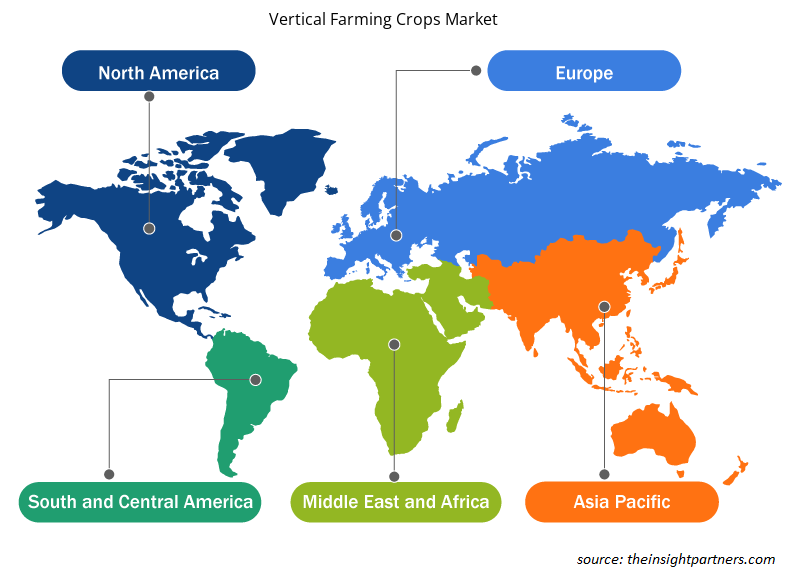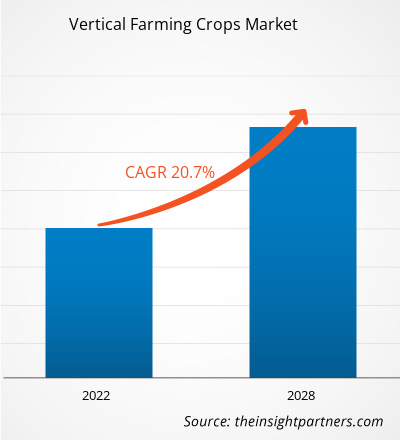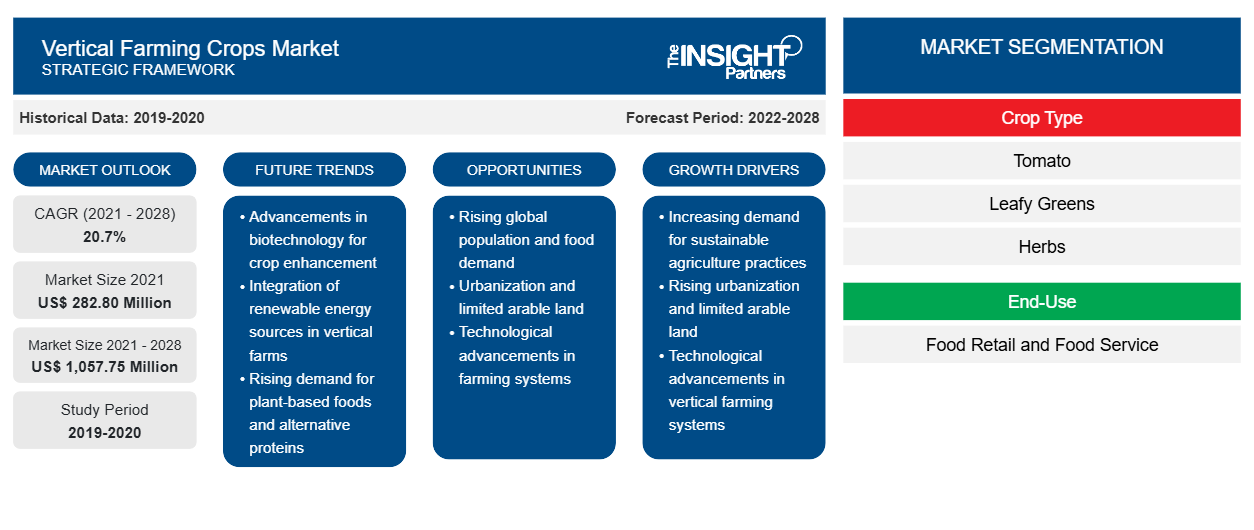[研究报告] 2021 年垂直农业作物市场价值 2.828 亿美元,预计到 2028 年将达到 10.5775 亿美元。预计 2021 年至 2028 年的复合年增长率为 20.7%。
垂直农业是指在由营养介质组成的托盘中垂直堆叠种植农作物。这是一种现代农业技术,种植农作物时不使用土壤或土地。此外,它不使用传统农业实践中通常使用的农药、化学肥料或其他合成材料。在耕地短缺的城市地区, 垂直农业正被越来越多地采用。
预计在预测期内,亚太地区将以全球垂直农业作物市场最快的复合年增长率增长。推动市场发展的主要因素是技术创新和对有机食品的需求不断增加。亚太地区的人口正在急剧增加。人口增长刺激了粮食需求,这进一步为垂直农业作物市场参与者提供了机会。此外,城市化进程的加快和现代农业实践的日益普及也在推动市场的发展。
此外,主要的垂直农业作物市场参与者正在积极关注创新。主要公司正在大力投资研发,并采用新兴技术来提高产量。例如,总部位于悉尼的初创公司 PodPlants 开发了轻便的便携式垂直花园,并凭借其独特的技术赢得了澳大利亚创新挑战赛。预计此类技术进步将在未来一段时间内推动区域市场增长。
定制此报告以满足您的需求
您可以免费定制任何报告,包括本报告的部分内容、国家级分析、Excel 数据包,以及为初创企业和大学提供优惠和折扣
-
获取此报告的关键市场趋势。这个免费样品将包括数据分析,从市场趋势到估计和预测。
COVID-19 对垂直农业作物市场的影响
COVID-19 疫情给各行各业带来了前所未有的挑战,全球食品和饮料行业也不例外。由于封锁、旅行禁令和制造厂关闭,供应链严重中断,导致销售额下降。此外,由于原材料和劳动力短缺,制造业面临产品供应短缺。然而,由于对本地生产、新鲜和有机产品的需求,垂直农作物市场实现了正增长。此外,个人健康意识的增强预计将在未来几年为垂直农作物带来盈利增长机会。
市场洞察
人工智能控制的垂直农场日益流行
人工智能控制的垂直农场通过提供与作物生长模式相关的数据,帮助种植者优化作物产量,包括哪些作物产量更高、作物所需的气候条件以及其他此类因素。种植者可以分析这些数据并采取必要的措施来提高产量。人工智能 (AI) 可以帮助该行业应对气候变化和资源可用性低等最大挑战,从控制主要作物生长到预测哪些作物产量更高。人工智能也在崛起,目前已有 1,600 多家初创企业,总投资额达到数百亿美元。人工智能控制的机器人监测植物生长情况,不断调整环境因素,以确保更高的效率和经济产出。因此,人工智能 (AI) 和物联网 (IoT) 预计将成为垂直农业作物市场的主要趋势。
作物类型洞察
根据作物类型,垂直农业作物市场细分为西红柿、绿叶蔬菜、香草和其他。绿叶蔬菜部分在 2019 年占据了最大的市场份额,香草部分预计在预测期内将在市场上实现最高的复合年增长率。绿叶蔬菜包括生菜、羽衣甘蓝、羽衣甘蓝、菠菜、水菜、甜菜叶和微型蔬菜。绿叶蔬菜适合室内种植,因为它们可以在相对较小的空间内快速生长。食品零售和食品服务业对新鲜绿叶蔬菜的需求不断增长,是推动该领域增长的主要因素之一。此外,“从农场到餐桌”的新鲜趋势也推动了对垂直种植绿叶蔬菜的需求。室内种植绿叶作物的研发支出激增,为市场增长提供了丰厚的机会。
最终用途洞察
根据最终用途行业,垂直农作物市场细分为食品服务和食品零售。食品零售部门在 2020 年占据了更大的市场份额。由于当地食品分销商、餐馆和咖啡馆以及快餐店对新鲜和高质量农产品的需求增加,预计食品服务部门在预测期内的复合年增长率将更高。此外,顾客越来越倾向于在餐馆和咖啡馆消费新鲜沙拉,这推动了食品服务行业对垂直农作物的需求。一些市场参与者正在与食品服务提供商合作以扩大业务。例如,2019 年 1 月,食品服务供应商 Van Gelder 和 PlantLab 达成合作,在 PlantLab 完全控制的垂直农业部门生产各种新鲜蔬菜。预计此类合作伙伴关系将在未来几年进一步推动市场发展。
农业技术见解
根据耕作技术,垂直农作物市场细分为水培、气培和鱼菜共生。水培部分在 2020 年占据了最大的市场份额,而气培部分预计在预测期内将在市场上实现最高的复合年增长率。在水培中,植物根部浸没在装有营养液的托盘中。在过去几年中,使用垂直水培系统的城市农业引起了广泛关注。这些水培农场可以使用最新技术优化植物生长,提供新鲜农产品,同时最大限度地减少用水量、土地空间、运输成本和农药使用量。水培通常可以生产出高质量的作物,通过采用人工智能 (AI) 和物联网 (IoT) 技术等新兴技术,种植者可以获得更好的作物产量。
全球垂直农业市场的一些主要参与者是 AeroFarms、Agricool、BOWERY FARMING INC.、CropOne、Infarm、Plantlab、Plenty Unlimited Inc.、Gotham Greens、MIRAI Co. Ltd. 和 BrightFarms。这些公司正在对新兴技术进行巨额投资,以提高农作物产量并以实惠的价格生产出高质量的农作物。
垂直农业作物市场区域洞察
Insight Partners 的分析师已详细解释了预测期内影响垂直农业作物市场的区域趋势和因素。本节还讨论了北美、欧洲、亚太地区、中东和非洲以及南美和中美洲的垂直农业作物市场细分和地理位置。

- 获取垂直农业作物市场的区域具体数据
垂直农业作物市场报告范围
| 报告属性 | 细节 |
|---|---|
| 2021 年市场规模 | 2.828亿美元 |
| 2028 年市场规模 | 10.5775亿美元 |
| 全球复合年增长率(2021 - 2028) | 20.7% |
| 史料 | 2019-2020 |
| 预测期 | 2022-2028 |
| 涵盖的领域 |
按作物类型
|
| 覆盖地区和国家 |
北美
|
| 市场领导者和主要公司简介 |
|
垂直农业作物市场参与者密度:了解其对业务动态的影响
垂直农业作物市场正在快速增长,这得益于终端用户需求的不断增长,这些需求源于消费者偏好的不断变化、技术进步以及对产品优势的认识不断提高等因素。随着需求的增加,企业正在扩大其产品范围,进行创新以满足消费者的需求,并利用新兴趋势,从而进一步推动市场增长。
市场参与者密度是指在特定市场或行业内运营的企业或公司的分布情况。它表明在给定市场空间中,相对于其规模或总市场价值,有多少竞争对手(市场参与者)存在。
在垂直农业作物市场运营的主要公司有:
- 航空农场
- 农业冷库
- Bowery 农业公司
- 作物一号
- 农场
免责声明:上面列出的公司没有按照任何特定顺序排列。

- 获取垂直农业作物市场顶级关键参与者概览
报告亮点
- 垂直农业作物市场的渐进式行业趋势可帮助参与者制定有效的长期战略
- 发达市场和发展中市场采用的业务增长战略
- 2019 年至 2028 年垂直农业作物市场的定量分析
- 全球垂直农业作物需求量估计
- PEST 分析可说明行业内买家和供应商的效率
- 了解竞争市场状况的最新发展
- 市场趋势和前景以及推动和制约垂直农业作物市场增长的因素
- 通过强调支撑商业利益的市场策略来协助决策过程,从而促进市场增长
- 垂直农业作物市场规模在不同节点的大小
- 市场的详细概述和细分,以及垂直农业作物行业动态
- 各地区垂直农业作物市场的规模以及良好的增长机会。
根据作物类型,垂直农业作物市场分为西红柿、绿叶蔬菜、香草等。根据最终用途行业,市场分为食品零售和食品服务。根据耕作技术,市场分为水培、气培和鱼菜共生。
- 历史分析(2 年)、基准年、预测(7 年)及复合年增长率
- PEST和SWOT分析
- 市场规模、价值/数量 - 全球、区域、国家
- 行业和竞争格局
- Excel 数据集
近期报告
客户评价
购买理由
- 明智的决策
- 了解市场动态
- 竞争分析
- 客户洞察
- 市场预测
- 风险规避
- 战略规划
- 投资论证
- 识别新兴市场
- 优化营销策略
- 提升运营效率
- 顺应监管趋势























 获取免费样品 - 垂直农业作物市场
获取免费样品 - 垂直农业作物市场